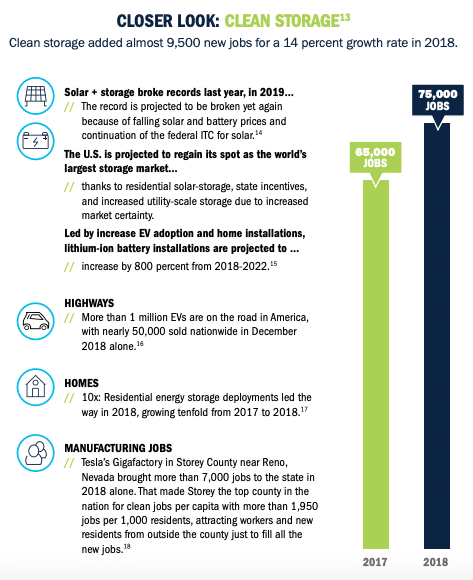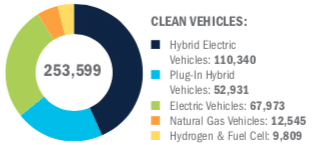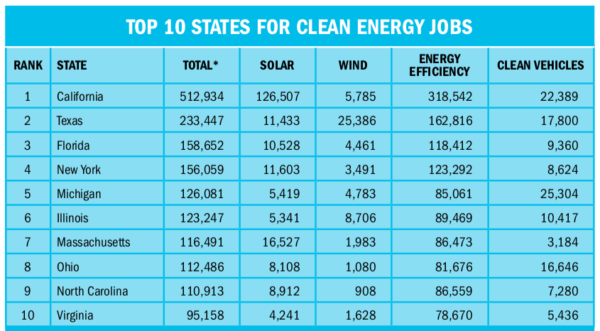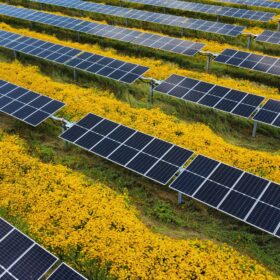While the once-steady rise in solar employment has flattened and even declined slightly over the past two years, job creation in other clean energy sectors is booming. A recent report by Environmental Entrepreneurs (E2) finds that U.S. jobs in its “clean storage” and “clean vehicles” categories grew 14% and 16%, respectively, to 75,000 and 254,000.
 The report ties the rise in batteries to deployment, which echoes earlier figures by Wood Mackenzie’s latest report which finds that the United States installed 80% more energy storage (as measured by MWh) in 2018 versus 2017, with more growth expected in future years.
The report ties the rise in batteries to deployment, which echoes earlier figures by Wood Mackenzie’s latest report which finds that the United States installed 80% more energy storage (as measured by MWh) in 2018 versus 2017, with more growth expected in future years.
 The much larger “clean vehicles” category, which includes hybrid vehicles as well as electric vehicles (EVs) grew 16% to 254,000 jobs, 68,000 of which were in electric vehicles themselves. E2 notes that more than 7,000 jobs were brought to Nevada by Tesla’s Gigafactory alone, and that the county the factory is located in has nearly 2 clean energy/manufacturing jobs for every resident.
The much larger “clean vehicles” category, which includes hybrid vehicles as well as electric vehicles (EVs) grew 16% to 254,000 jobs, 68,000 of which were in electric vehicles themselves. E2 notes that more than 7,000 jobs were brought to Nevada by Tesla’s Gigafactory alone, and that the county the factory is located in has nearly 2 clean energy/manufacturing jobs for every resident.
China dominates manufacturing
One of the ironies of U.S. job growth in these two industries is that the actual making of the lithium-ion batteries which are used exclusively in EVs and dominate stationary energy storage is increasingly dominated by China. More centrally, China also increasingly controls the supply of the three key processed materials that are needed to make these batteries.
A recent report by Benchmark Minerals finds that the United States had only 28 gigawatt-hours of annual lithium-ion battery manufacturing capacity in 2018 (the large majority of which is Tesla’s gigafactory), compared to China which has 193 gigawatt-hours.
More centrally, Simon Moores, the managing director of Benchmark Minerals, testified before the U.S. Senate last month that China now supplies the majority of processed lithium, cobalt and graphite which are needed in lithium-ion batteries, despite mining less than 5% of the world’s lithium and graphite, and a negligible portion of its cobalt.
“We are in the midst of a global battery arms race in which the United States is presently a bystander,” stated Moores in his testimony.
As such, while the United States may gain jobs in deployment, if trends are not reversed it will cede the vast majority of jobs in making lithium-ion batteries and EVs to China.
Other clean energy industries
E2 also looks other other clean energy sectors including solar, wind and energy efficiency. The organization’s numbers for solar jobs are roughly 50% higher than those calculated by the Solar Foundation, which has become the definitive source for solar employment statistics.
By E2’s count, solar jobs were roughly equal to the combined total of energy storage and “clean vehicles” jobs, and similar to other studies the report finds that solar jobs outnumber wind jobs 3-1, despite wind generating roughly 3x as much electricity in the United States as solar during 2018.
By far the largest sector of jobs identified by E2 was in the energy efficiency category, with LED, compact fluorescent and efficient lighting jobs outnumbering solar jobs. The group also provided a state-by-state breakdown of clean energy jobs, with California well in the lead driven by both its large solar and energy efficiency sectors, and Michigan unsurprisingly leading in clean vehicles.

This content is protected by copyright and may not be reused. If you want to cooperate with us and would like to reuse some of our content, please contact: editors@pv-magazine.com.









By submitting this form you agree to pv magazine using your data for the purposes of publishing your comment.
Your personal data will only be disclosed or otherwise transmitted to third parties for the purposes of spam filtering or if this is necessary for technical maintenance of the website. Any other transfer to third parties will not take place unless this is justified on the basis of applicable data protection regulations or if pv magazine is legally obliged to do so.
You may revoke this consent at any time with effect for the future, in which case your personal data will be deleted immediately. Otherwise, your data will be deleted if pv magazine has processed your request or the purpose of data storage is fulfilled.
Further information on data privacy can be found in our Data Protection Policy.